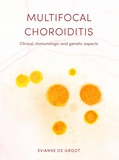Multifocal choroiditis
Clinical, immunological and genetic aspects

Groot, Evianne de
- Promoter:
- Prof.dr. J.H. (Joke) de Boer & prof.dr. C. (Carel) Hoyng
- Co-promoter:
- Dr. J. (Jeanette) Ossewaarde-van Norel & dr. J.J.W. (Jonas) Kuiper
- Research group:
- Boer Kuiper
- Date:
- June 29, 2023
- Time:
- 14:15 h
Summary
In this thesis we explored the clinical and genetic risk factors for idiopathic multifocal choroiditis (MFC). MFC is a rare ocular disease affecting the choroid in the posterior pole of the eye. This relapsing disease predominantly affects relatively young women with myopia. The complication of the growth of secondary choroidal neovascularization (CNV) occurs frequently and threatens the visual function in these patients.
In the first part of this thesis, we explored clinical risk factors associated with an increased relapse rate and the efficacy of several treatment options. We discovered that the presence of the complication of CNV at the first presentation and the level of myopia were both significantly associated with the relapse rate. Moreover, in this part we described that treatment with disease modifying rheumatic drugs (DMARDs) significantly decreased the relapse rate, however relapses were still observed in the majority of the patients. Furthermore, we described the efficacy of adalimumab in 14 patients and found that this therapeutic agent is very effective in the majority of the patients.
In the second part of this thesis, we explored imaging characteristics that were associated with disease activity using a multimodal imaging approach. We found several imaging characteristics that were associated with disease activity including an increased choroidal thickness on optical coherence tomography and increased area of hypoperfusion of the choriocapillaris visualized with indocyanine green angiography and optical coherence tomography angiography.
In the third part of this thesis, we explored immunological and genetic risk factors. In a genome-wide association study we discovered a single nucleotide polymorphism (SNP) in the complement factor H gene that was significantly associated with idiopathic MFC. Moreover, using the Olink platform, we demonstrated that the risk genotype of this SNP significantly increased the protein concentrations of several proteins in two biological pathways: the complement cascade and the activation of platelets. Lastly, in collaboration with the Utrecht Patient Oriented Database, we found that increased granularity of the platelets, measured with automated hematocytometry, was an independent risk factor for treatment with a DMARD.